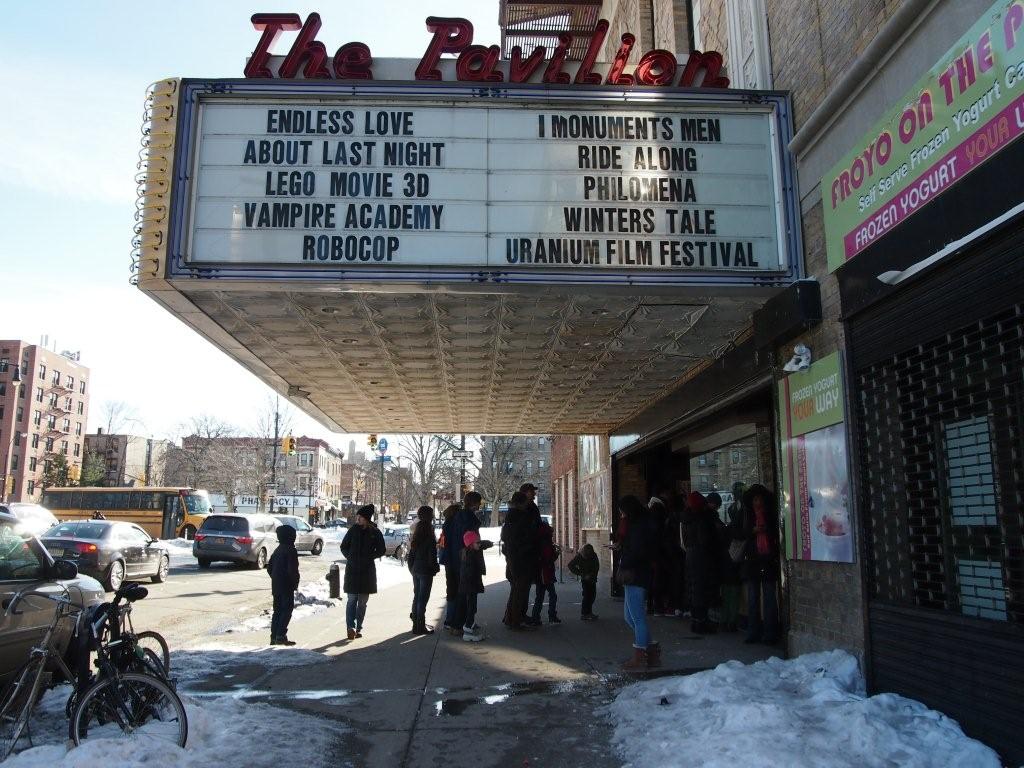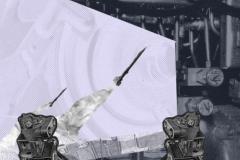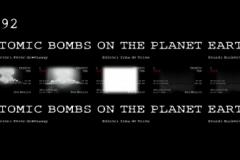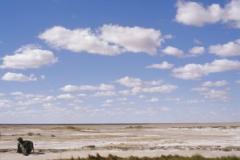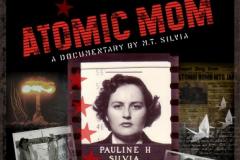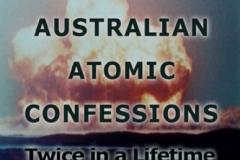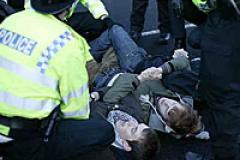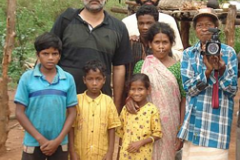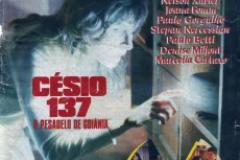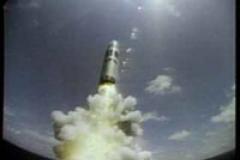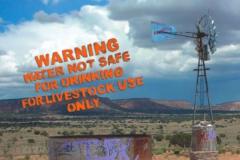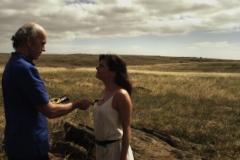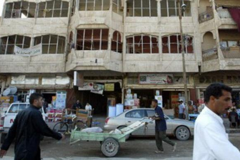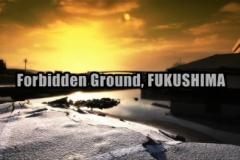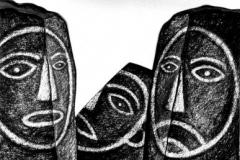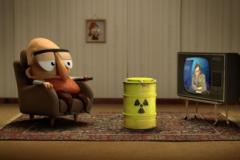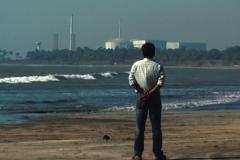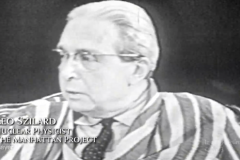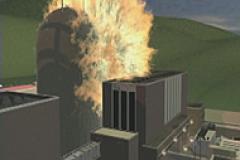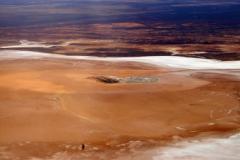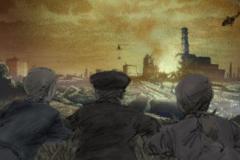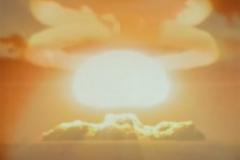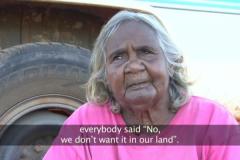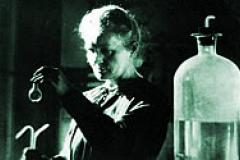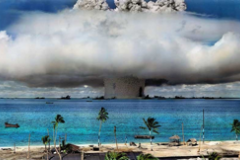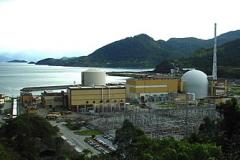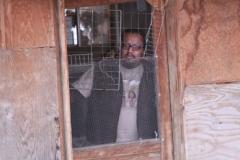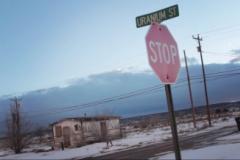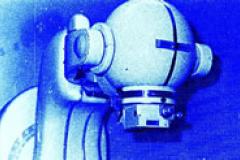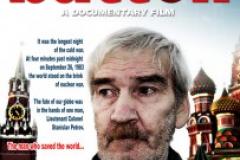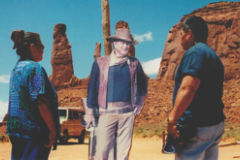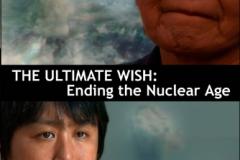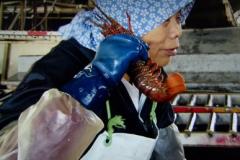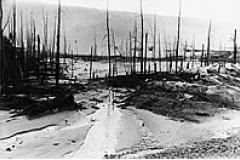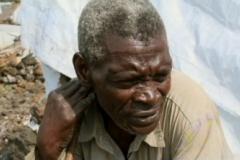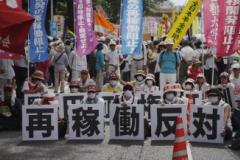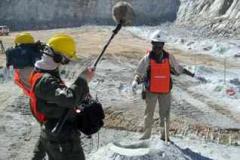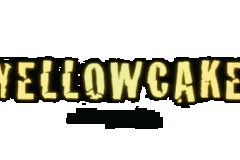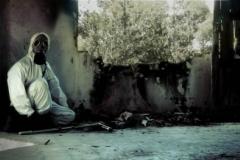FROM RIO TO THE BIG APPLE
International Uranium Film Festival in Washington DC, Goethe Institute, February 10-12, 2014 and New York City, Brooklyn, The Pavilion Theater, February 14-19, 2014.
„Each film, unique in style, perspective and motivation, focused on a different area affected by the nuclear fuel production cycle. The films confront viewers with the realization that we all share the same threat to humanity, the biosphere and the atmosphere. The documentaries impart a sense of responsibility for the negative heritage we are imparting to future generations. We are all equally subject to the ramifications of nuclear runoff.“ Peace Boat US
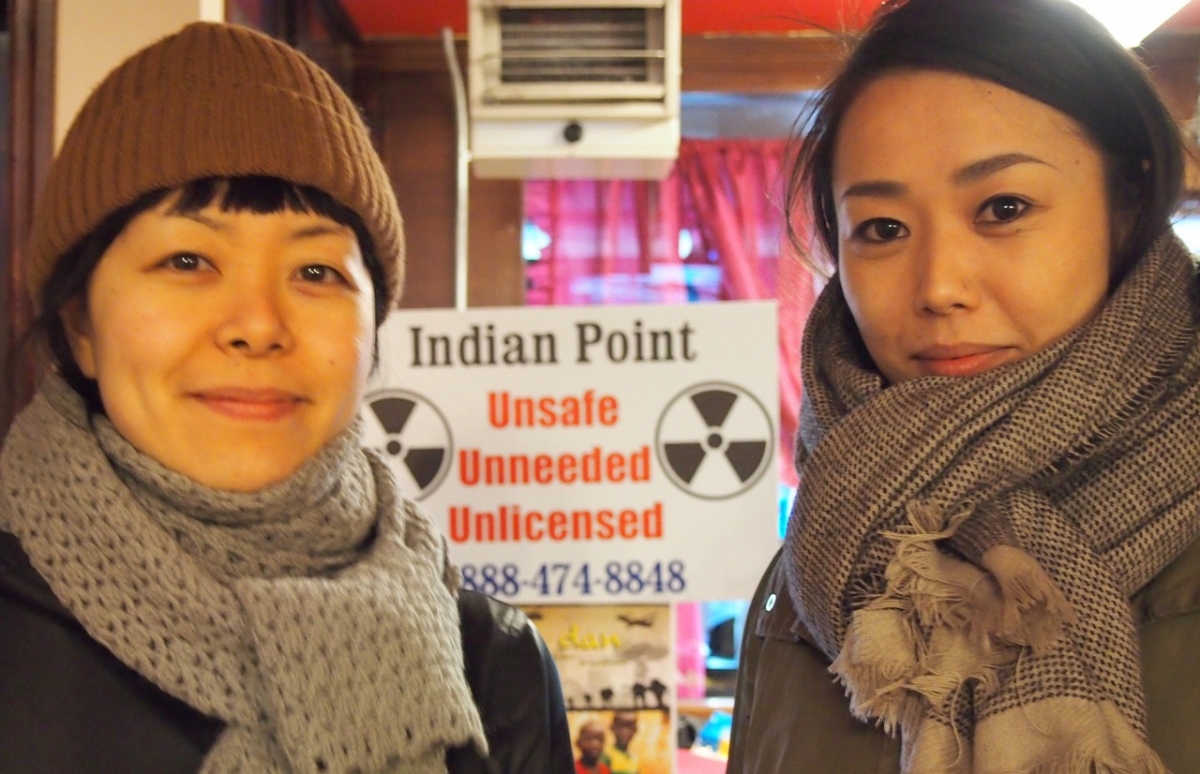 The Uranium Film Festival Team is grateful to the Heinrich Böll Foundation North America and the Goethe Institute Washington DC for supporting and hosting the festival in February 2014. We are also grateful to our partners and supporters in New York City, especially to Peace Boat US and to the owners of the Pavilion Theater, an historic Art Deco movie theater at Prospect Park inaugurated in 1928.
The Uranium Film Festival Team is grateful to the Heinrich Böll Foundation North America and the Goethe Institute Washington DC for supporting and hosting the festival in February 2014. We are also grateful to our partners and supporters in New York City, especially to Peace Boat US and to the owners of the Pavilion Theater, an historic Art Deco movie theater at Prospect Park inaugurated in 1928.
In addition the Uranium Film Festival in NYC would not have been possible without the exceptional commitment and support from festival co-organizer Yuko Tonohira (an NYC illustrator and activist) and Cathey Falvo, member of the Physicians for Social Responsibility - New York City Chapter (PSR/NY). (Photo Yuko Tonohira (left) and a Peace Boat US volunteer at the freezing Pavilion Theater)
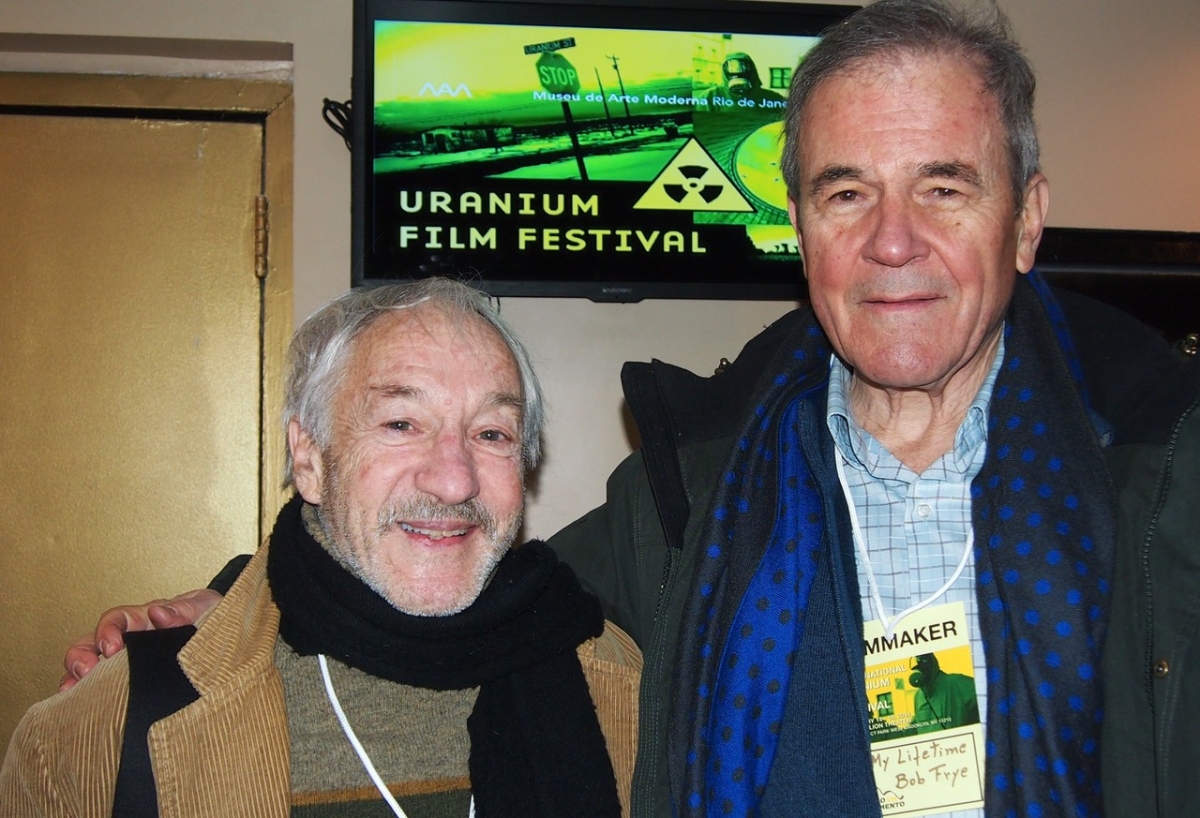 It was really and exceptional winter & Uranium Film Festival in DC and especially in New York. It was extremely freezing and heavily snowing and the heating in the historic pavilion theater was unfortunately out of service. Nevertheless it was an unforgettable event with the participation of a wonderful audience and amazing filmmakers like Eve-Andrée Laramée (US), Bill Keisling (US), David Rothauser (US), Robert Richter (US), Robert E. Frye (US), Adam Jonas Horowitz (US), Shri Prakash (India), Pradeep Indulkar (India) and Walter Behr (Brazil). (Photo David Rothauser and Robert Frye)
It was really and exceptional winter & Uranium Film Festival in DC and especially in New York. It was extremely freezing and heavily snowing and the heating in the historic pavilion theater was unfortunately out of service. Nevertheless it was an unforgettable event with the participation of a wonderful audience and amazing filmmakers like Eve-Andrée Laramée (US), Bill Keisling (US), David Rothauser (US), Robert Richter (US), Robert E. Frye (US), Adam Jonas Horowitz (US), Shri Prakash (India), Pradeep Indulkar (India) and Walter Behr (Brazil). (Photo David Rothauser and Robert Frye)
Peace Boat US volunteer Rachel Clark who attended the Uranium Film Festival in Brooklyn reported: „Living in Metropolitan New York area, we often only see the threat of nuclear power plants to local residents, whose stances are from the viewpoint of both energy consumers and (potential) victims. At the Pavilion Theater, however, many audience members were shocked by the chaotic situation at the uranium production sites. Scenes depicting uranium mining workers in India and Africa working without any protective gear, bulldozers generating radioactive dusts and mounds of radioactive dirt in order to obtain just a handful of yellow cake—the extracted pure form of uranium— and radioactive toxic waste being dumped into rivers, ponds, and open air left a lasting impact.“
IUFF USA 2104 - NEW YORK CITY, FEB 14TH TO 19TH
FROM FRI, 14th TO WED, 19th, 2014.
THE INTERNATIONAL URANIUM FILM FESTIVAL IN BROOKLYN - NYC
ART & NUCLEAR AWARENESS: The International Uranium Film Festival comes for the first time to Washington DC and New York, to put under the spotlight Human Rights and the consequences of Nuclear Power, Atomic Bombs, Uranium Mining, Depleted Uranium Weapons.
[nyc-2014]
@ The Pavilion Theater
188 Prospect Park West (bet 14th and 15th st), Brooklyn, NY 11215
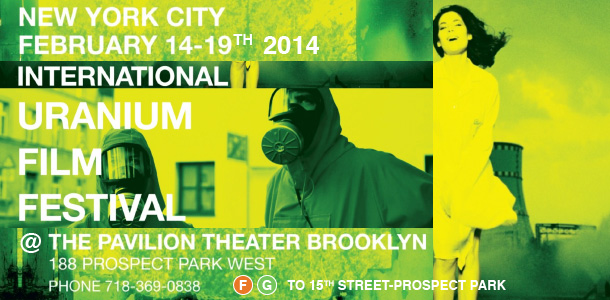
> FESTIVAL PROGRAM & POSTER FOR DOWNLOAD
Argentine/Brazil, 2012, 106 min, Portuguese with English subtitles
Production: O Movimento Falso Filmes
Documentary
The Hibakusha of Brazil. August 6, 1945, at quarter past eight in the morning the USA are dropping the first atomic bomb on the civilian population of the city of Hiroshima. This documentary chronicles the lives of survivors of Hiroshima who are now living in Brazil.came to live in Brazil...
Germany, 2012, 4 min, no dialogue
Animation
World Premiere
Animated short film about Fukushima children who can't play outside. About their dreams and realities.
Bachelor in 2012 of Shoko Hara and Paul Brenner
Sound design and Music: Lorenz Schimpf
Teachers: Prof. Klaus Birk, Alexander Hanowski, Martin Hesselmeier
DHBW Ravensburg, Studiengang Mediendesign
Director Paul Brenner present, Munich 2013
USA, 2011, 6 min, English
Animation/Experimental
Producer: Nathan Meltz
Latin American Premiere
The film remakes a section of the 1983 post-nuclear made-for- TV movie 'The Day After', retelling the story of atomic devastation in a Dada collage-meets-stop-animation style. The film showed atomic bombs reducing humans and animals to skeletons, and a city was blown to rubble.
Brazil, 2002, 4 min, Portuguese
Fiction
One of the first victims of the radioactive accident of Goiânia with Cesium-137 September 1987 was a 6 year old child. Leide das Neves had no time to play.
UK/The Netherlands | 2011 | 13 min | Art & Experimental documentary
Director: Peter Greenaway, Video Design Irma de Vries
Producer: Change Performing Arts www.changeperformingarts.com | Language: Multilingual
Synopsis: Very surprisingly from 1945 to 1989 there have been 2201 atomic bombs dropped on the planet Earth - an astonishing number of atomic bombs implying huge destruction and fall-out. The film shows evidence of every bomb explosion documented with the nation responsible, the date and location, the force and the height about earth or sea level in a relentless build up of accumulating destruction that is both inspiring and dreadful in the true biblical sense of the phrase - full of dread.
Video: https://www.youtube.com/watch?v=Mc3EKAszRAw
Awards: International Uranium Film Festival Hors Concours Award, Rio de Janeiro 2012
Australia, 2006, 14 min, English
Documentary
Australia is facing what could be the largest expansion of our nuclear industry ever, with the proposals for increased uranium mining, nuclear power generation and a radioactive waste dump. This film looks at some of the reasons why we must continue to oppose nuclear proliferaton.
(Atomny Ivan)
Russia, 2012, 91 min, Russian, English subtitles
Production: Telesto Film Company
Romantic Comedy
That is a plane story of people from the future which is getting to be real nowadays. The heroes are beautiful and helpless, but they continue to fight for their own happiness and purport. The story takes place in the town where the nuclear engineer may live in one apartment with his mother, the nuclear engineer and his grand-mother – the pioneer of nuclear industry. The story is really outstanding, it is about Ivan and Tania, Tania is interested in her science carrier and Ivan is not interested in anything, but Tania. The new third hero makes heroes to wake up. A lyrical comedy.
Producer Victoria Gromik present, Munich 2013
Japan/USA, 2010, 80 min, English, English subtitles
Documentary
Atomic Mom weaves an intimate portrait of a complex mother-daughter relationship within an obscure moment in American history. Pauline Silvia, the filmmaker's mother, undergoes a crisis of conscience about her work in the military during the early 1950's Atomic Testing Program.
The film follows these mothers, each on a different end of atomic warfare, as they attempt to understand the other.
Australia, 2005, 49 min, English and Aboriginal Australian
Documentary
Latin American Premiere
Sacrificial lambs to the slaughter. Eyewitnesses tell the true story of what happend during the 12 British atomic bomb tests in Australia. The film is a chilling expose of nuclear testing and the demaging legacy that continues these day.
United Kingdom, 2010, 71 min, English
Directors and Producers: Meera Patel and Wolfgang Matt
Production: Maddmovies
Documentary
A story about the biggest weapons of mass destruction ever created, the people who use them and, more importantly, the people who fight them. 'Beating the Bomb' charts the history of the British peace movement against the backdrop of the atomic age. The film also frames the nuclear weapons issue within the wider context of global justice.Beating the Bomb, United Kingdom, 2010, 71 min.
www.beatingthebomb.com, contact: maddmovies@gmail.com
"Beating the Bomb" was selected by the Uranium Film Festival Jury as one of the eight best documentaries of the festival.
Best documentary award, Red Rock Film Festival, Utah, USA
Australia, 2005, 62 min, English
Production: Frontline Film Foundation
Documentary
Latin American Premiere
Blowin' in the Wind examines the secret treaty that allows the US military to train and test its weaponry on Australian soil. It looks at the impact of recycled uranium weapons and the far-reaching physical and moral effects on every Australian. The film's release has been timely as the government currently moves to approve more uranium mines while arguing the contrary - that by going nuclear we are being both 'safe' and 'green'. The film reveals that Iraqi babies are now being born with major birth defects. Bradbury wonders whether Australians living downwind from the military testing ranges will be next. He argues that we were lied to by the British over the Woomera and Maralinga atomic tests. Can we trust another equally powerful partner in our 'war on terror'?
With a cash budget of just $12,000 the film raises pertinent questions which cannot be ignored by the Australian public. The film shocked, angered and surprised large audiences when shown at the Sydney and Brisbane Film Festivals.
www.frontlinefilms.com.au/videos/blowin.htm
(Ragi Kana Ko Bonga Buru)
India, 1999, 52 min, English
Documentary
Not part of the Competition
"Buddha Weeps in Jadugoda" is a documentary film on uranium mining and its deadly impacts on the tribal people living near the Jadugoda mine, mill and tailings dam, in the East Singhbhum district of Jharkhand (India). Unsafe mining, milling and tailings management by UCIL in this area for almost 30 years has resulted in excessive radiation, contamination of water, land and air, destruction of the local ecology, and lead for to genetic mutation, and slow death for the people of the region. The film attempts to depict the gross misuse of power by the authorities in displacing the original inhabitants of the region, the utter lack of concern for internationally accepted norms and safety precautions in the handling of uranium and its by-products, and their callousness of its disastrous impact on the people and the region.
Director Shri Prakash present, Berlin 2012
Q&A with Shriprakash + RAOUF DABBAS, Amman 2014
Brazil, 1989, 95 min, Portuguese, English subtitles
Producer: Laura Pires
Doc Fiction
AUDIENCE AWARD BEST FEATURE FILM 2011
In the ruins of a demolished hospital for cancer treatment in the centre of the Brazilian city Goiânia, two young men found an old "forgotten" Teletherapy Unit, which contained a highly radioactive "Caesium 137 bomb". They sold it to a local scrap metal dealer, who opened that Pandora's box. People were fascinated by the dazzling blue light of the caesium crystals. But they did not know, that it was the shine of the death. Hundreds if not thousands of the citizens and visitors of Goiânia became victims of Caesium 137. The script of the movie is based on statements by the victims and medical personal attending the victims, taken by Roberto Pires at the time of the accident.
(Verstrahlt und vergessen, Tschernobyl und die Folgen)
Germany, 2006, 59 min, German/ Russian, English Subtitle
Production: ARTE – WDR
Brazilian Premiere
April 26th 1986. The day a nightmare scenario became horrific reality: the day reactor block 4 of the Chernobyl atomic power station exploded. While researching and filming this project filmmaker Christoph Boekel met numerous victims of the atomic catastrophe. His own wife was one them and she, too, died of cancer. A moving film told from the personal perspective of the director, it is a requiem for the often forgotten victims of the disaster and a caveat against putting blind trust in technological advancement.
Estonia, 2012, 14 min, without dialog
Comedy Thriller
Producer: Tallinn University Baltic Film and Media School; Estonian Academy of Arts
"What would happen if I gave some of my dad's nuclear liquids to my pet rat?" the kid thought as he poured some uranium into his rat's bowl. BANG!! Curiosity Kills is a splatter comedy about a radioactive killer rat.
USA, 1991, 29 min
Documentary
The documentary uncovers the disastrous health and environmental side effects caused by the production of nuclear materials by the General Electric Corporation. The film juxtaposes GE's rosy "We Bring Good Things to Life" commercials with the true stories of people whose lives were devastated by the company's involvement in testing and making nuclear weapons. Driven by intensely personal testimony and painstaking research, "Deadly Deception" exposes what GE never wanted its customers to know: a shocking pattern of negligence and misinformation spanning several decades. Nine months after this film won the Oscar®, GE pulled out of its work in the nuclear weapons industry, and Corporate Accountability International organizers of the GE boycott, declared victory in their grassroots campaign. The 1991 Academy Award®- winner for Best Short Documentary, Deadly Deception unco-vers the disastrous health and environmental side effects caused by the production of nuclear materials by the General Electric Corporation. The film juxtaposes GE's rosy "We Bring Good Things to Life" commercials with the true stories of people whose lives were devastated by the company's involvement in testing and making nuclear weapons.
Contact: www.groundspark.org
(Dii'go To Baahaane)
USA | 2012 | 33 min | Documentary
Directors: Deborah Begel and David Lindblom
Executive Producers: Dr. Johnnye Lewis and Chris Shuey
Original language : Navajo & English | Subtitles: English
This documentary is a four part meditation on the Navajo people’s problems with contaminated drinking water. Nearly one out of three people in the Navajo Nation struggle with this issue. Four Stories About Water opens with a waterfall of people who reveal the scope of water contamination problems on Navajo lands, from the health problems that were likely caused by uranium tailings left uncovered to the view of water as “a spiritual element” to the fact that 30% of the Navajo people don’t have access to safe water. «For us Diné people, if we treat water with respect and have spiritual faith, water will respect us. In this way, we will go forward in a balanced and harmonised life. » David Begay
Australia, 2012, 87 min, English
Producer: Tom Young
Science fiction
World Premiere
In the not too distant future, the newly formed Independent Republic of South Australia is the phoenix that rises from the ashes of a decaying and corrupt Australian Commonwealth, becoming wealthy beyond imagination on the back of uranium. However, the real power lies with Double Happiness Uranium, a massive global energy corporation secretly developing the ultimate weapon, a neutron bomb that targets the biological cells of select individuals.
Spain, 2011, 13 min, English
Fiction
A man breaks into an apartment carrying a big black backpack. He is wearing an anti radiation suit. The place looks abandoned the radiation levels are crazy high. Then he looks around and starts searching for things to steal. Soon he will realize he is not alone.
What happens inside an exclusion zone where no one is supposed to be? Is there any people left? If that's the case, are they suffering? This short is meant to answer all those questions.
(Irak: Les Enfants Sacrifiés De Falluja)
Irak/France | 2011 | 48 min | Documentary
Director: Feurat Alani | Producer: Baozi Production
Original Language: English and French
In 2004, Fallujah in Iraq became the theater of a major showdown between american army and iraq insurgents. But what the american used in this war is secret. What kind of weapons did they drop? For now and since 2005, deformed babies are born. What really happened in Fallujah? Is depleted uranium the cause of the health problem?
Film website: http://www.baoziprod.com/New/?p=3440
Director's Blog: http://feuratalani.blogspot.com.br
Awards:
Investigation award and Remand Center Award in Grand Scoop Festival in Lille, 2011
Freedom and human rights Award in Al Jazeera Festival in Qatar in April 2012
International Committee of the Red Cross Award in Monte-Carlo’s Festival in June 2012
Public Award and Jury Award in Khouribga Documentary Film Festival (Morocco), 2012
USA, 2012, 18 min, Japanese/English, English subtitles
Producer: Yoko Kumano
Documentary
World Premiere
The film addresses the isue of radiation in food after the March 11, 2011, Fukushima desaster. The film features interviews with food producers, restaurant owners and new parents about the food consumption has changed after the nuclear accident and the contamination of the food chain with radioactive elements.
(Gere Dan)
India, 2014, 48 min, French/English with English subtitle
World premier in NewYork City
Niger, Gabon, Congo and other African countries had been going through the experience of Uranium mining since decades. But now more and more Uranium mining companies are going to Africa more aggressively. Poverty, lack of governance and political instability has made this area as heaven for these mining companies. This film is trying to looking from inside of a tiny village 'Falea' in Mali where drilling for prospecting of uranium is going on, and same time also try to see the multiple dimensions of the uranium mining and vested interests of world powers in that same sub-Sahara region.
Both filmmakers are present (New York 2014).
Japan, 2012, 57 min, Japanese, English subtitles
Documentary
World Premiere
It is a documentary on the aftermath of the disaster in Fukushima.
Someone said "Fukushima, it's like a parallel world". It's another world. Apparently, from the outside, everything looks normal. Outside the exclusion zone of 20km, life continues as before, but not quite, this is only an appearance. The danger is invisible. My challenge is: how to make visible what is invisible.
USA | 1997 | 9 min | Animation
Director: Karen AQUA (1954 - May 30th, 2011) | Music by Ken Field
Language: No Dialogue
Synopsis: In south-central New Mexico, an ancient Native American rock art site lies 35 miles from the detonation site of the world’s first atomic bomb. The juxtaposition of these sites points to the striking contrast between the two worlds which created them: one which reveres and lives in harmony with the natural world, and one which, in striving to control the forces of nature, has created a means for its destruction. Film director's website: http://karenaqua.com
Awards:
Humboldt International Film Festival, CA, 1998: 1st Prize, Animation
Marin County National Festival of Short Films, CA, 1998: 1st Prize, Animation
Green Extreme Film Festival, Canada, 1999: Best Environmental Film
Prix Leonardo, Italy, 1999: Gold Certificate
International Uranium Film Festival SPECIAL ACHIEVEMENT AWARD 2012
(Halbwertszeit)
Germany, 2012, 20min, English subtitles
Production: Bauhaus-University Weimar
Science fiction
In the year 2022: After a serious meltdown in a German nuclear power plant the soil is contaminated and people live in constant threat of radioactive fallout. Low radiation vegetables are so precious that they can be proffered only in fine restaurants. Those can be ordered by the mysterious "Black Card".
So imagine how satirically: A story of a future where the food comes before morality.
(Herr Hoppe und der Atommüll)
Germany, 2011, 4 min
Producer Filmakademie Baden – Württemberg
Animation
A barrel of nuclear waste drops into the living room of Herr Hoppe an average suburbian German. He has to get rid of it and does it in his own wacky way.
USA, 2012, 54 min, English
Documentary with animation
This film is inspired to bring awareness to the Hiroshima and Nagasaki bombings in hopes that a nuclear tragedy like this will never happen again. "Hibakusha" is a Japanese term which refers to a survivor of the atomic bombing of Hiroshima and Nagasaki. The film was built around the story of Kaz Suyeishi, an 84-year-old survivor, who recalls her memories as an 18-year-old Japanese American student when the atomic bomb was dropped on her hometown of Hiroshima. Not only is the story compelling, but so is the form. Well into the project Steve Nguyen decided it shouldn't be a documentary with talking heads, it needed elements to bring to life the emotion of the time. And so the animated documentary was born, taking Kaz's memories and transforming them into animated reenactments. Steve Nguyen, who signed in from Los Angeles and Choz, from New York, began their creative collaboration in 2010 when Steve sought Choz out after hearing praise for his work as a director, including his work on two videos for the Far East Movement.
TRAILER
www.hibakushafilm.com
(Hibakusha - Unser Leben zu Leben)
USA, 2010, 78 min, English with German subtitles.
Memory Productions
Documentary
The stories of Japanese, Korean, and American Hibakusha: Survivers of the atomicbombs. Their stories are linked to the relationship between Eiji Nakanishi (one of youngest survivors of Hiroshima) and his little friend, Yoko, an eight year old girl he teaches to play the guitar. Little by little she learns about Eiji's hiba-kusha experience. She becomes intrigued by colorful pictures and drawings made by the survivors. Then she discovers Sadako and the story of the Thousand Cranes. "Will Eiji take me to thePeace Festival in Hiroshima?" The bombing of Nagasaki is shown through the sharp focus of a Shinto wedding ceremony. Back in America, Davey throws down his tin pot and wooden spoon of his Hiroshima-Nagasaki celebrations.
India | 2013 | 27 min | Documentary
Director: Pradeep Indulkar
Original Languages: Marathi/English | Subtitles: English, German, French
Synopsis:Tarapur Nuclear Power Project is India's first civil nuclear establishment came in existance around 50 years ago, displacing few villages near town named Tarapur. Once a protagonist visits those villages Dandi, Pofaran, Ghivali, Unbhat and Tarapur after 40 long years. He observes the situation of thousands of displaced people. He finds that they lost their traditional jobs and they did not get any new jobs, they lost their lands, homes and sea and they didn't get proper compensation neither they got the promised services and infrastructures like roads, water, electricity, medical facilities, schools etc. etc. Instead they got illness and unknown deceases. The high blood pressure and heart attack cases increased. Kidney failure and miscarriages and still births and complicated delivery cases increased. The kids below 5 years are suffering by mental disorders. Their IQ is low. The real cost of power is paid by those unknown and innocent people.
Film Website: http://highpowerdoc.webs.com/apps/links/
Awards:
YELLOW OSCAR, Best Short Documentary, International Uranium Film Festival Rio 2013
Mexico/Japan | 2010 | 73 min | Documentary
Director: Shinpei Takeda | Producer: Shinpei Takeda and Eiji Wkamatsu
Original Language: Japanese/English | Subtitles: French
Synopsis: For a younger generation of Japanese, can their experiences of atomic bomb be truly understood? How does this memory stay alive for the coming generation? As the two drove down the American west coast visiting 18 survivors of atomic bomb as well as a holocaust survivor, they would hear the most intimate moments of their lives and reveal the cruel nature of psychological scars. With the vast landscape of American west in their background, the two reflects on their relationship to the contemporary history of Japan. Director Shinpei Takeda has fallowed the atomic bomb survivors in both north and south Americas for the last 5 years.
Film website: http://www.shinpeitakeda.info/2012/01/23/hiroshima-nagasaki-download/
Awards:
SPECIAL ACHIEVEMENT AWARD, International Uranium Film Festival, Rio 2013
USA, 2011, 109 min, English with German subtitles
Documentary
In My Lifetime features moments in our history as well as current issues regarding nuclear weapons. This film is meant to be a wakeup call for humanity, to help develop an understanding of the realities of the nuclear weapon, to explore ways of presenting the answers for "a way beyond" and to facilitate a dialogue moving towards resolution of this Gordian knot of nuclear weapons gripping the world. The documentary's characters are the narrative voices, interwoven with highly visual sequences of archival and contemporary footage and animation. The story is a morality play, telling the struggle waged over the past six and half decades with the last act yet to be determined, of trying to find what is "the way beyond?"
USA, 2003, 29 min, English
Documentary
Latin American Premiere
Shows the impossibility of evacuation at Indian Point nuclear power plant outside NY City. Produced after the 9/11 terror attack on New York City and the terrorists announced they had targeted the Indian Point Nuclerar Power station but decided to fly by it to the Twin Towers instead.
Tobe Carey will attend the screening (New York, 2014).
Australia, 2012, 15 min, English subtitles
Production: Curtis Taylor & Eleanor Winkler
Currently the international mining company Cameco are conducting Uranium exploration in Kintyre, a remote part of the Western Desert in Western Australia. The traditional owners of the land, the Martu are currently in negotiation with Cameco over the future of their traditional country and are torn over issues of environmental conservation and financial prosperity. In 2011, Cameco arranged for a delegation of Martu community elders to travel to an established uranium mine at Rabbit Lake in Canada, which is situated in 1st Nation territory. A cultural exchange occurs between the 1st Nation and the Martu and as many questions as answers are sparked from the trip to Rabbit Lake.
Germany / Ukraine, 2011, 19 min, Russian, English Subtitles
Animated documentary
Producer: Tetyana Chernyavska
Yellow Oscar Best Animation Film 2012
A Soviet family searching for a modest paradise is swept into an immense disaster. This magically animated film combines drawing, photography and documentary video to capture the surreal emotions of the too-real tragedy: Chernobyl 1986.
Israel, 2012, 3 min, without dialog
Experimental
The video includes footages from authentic shots of bombing, from popular American movies and from propaganda movies that was created by the American government during the "cold war". The footages were edited in a technique that reminds the Photomontage that was used in photography in the end of the 19th century and in the Film-making between the two world-wars. The Photomontage brings up questions of reality and fiction and deals with the zone of ethics and aesthetics.
Australia, 2010, 10 min
Documentary
Muckaty Voices is a short film capturing Aboriginal community resistance to an Australian government plan to dump low and long lived intermediate level radioactive waste at Muckaty Station, 120km north of Tennant Creek in the Northern Territory. The government's push for Muckaty has sparked widespread criticism from the targeted community, trade unions, national health and environment groups and Indigenous organizations. A federal court challenge has been launched to contest the Muckaty nomination. The film presents the country and community affected by this proposal.
The film was produced for the Muckaty Traditional Owners by Enlightning Productions, with support of Beyond Nuclear Initiative: www.beyondnuclearinitiative.com
USA, 2010, 73 min, English
Documentary
Latin American Premiere
Yellow Oscar Best Feature Film 2012
For much of the twentieth century the United States Department of Defense was a major producer of radioactive waste. The Pentagon not only produced its own nuclear waste. For years, the Pentagon depended on an unknown number of private defense contractors to supply countless radioactive parts and equipment. In the mid-twentieth century, the U.S. government actually gave some of these defense contractors permission to dump radioactive waste on their private properties.
The Pentagon seldom, if ever, disclosed the whereabouts of these dangerous nuclear dumps. The problem becomes one for the ages: many of these radioactive isotopes remain dangerous and "hot" for thousands of years, even as the radiation is invisible to unsuspecting victims.
This carelessness caught up with college students in Lock Haven, Pennsylvania. One day the students woke up to find environmental officials dressed in protective "moonsuits" searching their apartment building for tell-tale signs of radioactive waste.
USA | 2012 | 87 min | Documentary
Director: : Adam Jonas Horowitz
Original Language: Marshallese & English | Subtitles: French / Spanish
Featuring recently declassified U.S. government documents, survivor testimony, and unseen archival footage, Nuclear Savage uncovers one of the most troubling chapters in modern American history: how Marshall islanders, considered an uncivilized culture, were deliberately used as human guinea pigs to study the effects of nuclear fallout on human beings.
Between 1946 and 1958 the United States tested 67 nuclear weapons above ground on or near Bikini and Enewetok atolls. The hydrogen bomb was 1000 times more powerful than the Hiroshima bomb. Entire islands were vaporized and populated islands were blanketed with fallout. As the film shows, the heavily exposed people of Rongelap were then enrolled as human subjects in the top-secret Project 4.1 and evacuated to a severely contaminated island to study the effects of eating radioactive food for nearly 30 years. Many of the Marshall Islanders developed cancers and had babies that were stillborn or with serious birth defects.
Nuclear Savage follows the islanders today as they continue to fight for justice and acknowledgement of what was done to them. Despite recent disclosures, the U.S. government continues to deny that the islanders were deliberately used as human guinea pigs. The film raises disturbing questions about racism, the U.S. government’s moral obligation to the people of the Marshall Islands, and why the government is continuing to cover up the intent of the tests and Project 4.1 after several decades.
Awards:
AUDIENCE AWARD, Best Film Cinema Planeta International Festival, Mexico
JURY PRIZE, Best Feature Documentary, Paris/FIFE International Festival of Environmental Films
JURY PRIZE, Chicago Peace on Earth Film Festival
YELLOW OSCAR, Best Feature Documentary, International Uranium Film Festival Rio 2013
More information:
http://ncronline.org/blogs/eco-catholic/yellow-oscar-goes-documentary-ex...
http://www.veteranstoday.com/2014/01/24/americas-nuclear-radiation-cover...
http://www.globalresearch.ca/media-coverup-of-impacts-of-u-s-nuclear-wea...
(Pedra Podre)
Brazil, 1990, 26 min, Portuguese with English subtitles
Documentary
It is the first Documentary made about the Brazil's nuclear power plants, Angra 1 and Angra 2 in the Atlantic Rainforest region in the South of Rio de Janeiro. With ironic humor, it shows that the official safety and evacuation plans to protect the local population and tourists in case of a nuclear meltdown are just a joke. Worse: Angra 1 and 2 are constructed on a beach, which the indigenous population (Guarani-Mbyá) called once Itaorna: Rotten Rock.
USA, 2011, 30 min, English
Producer: Yvonne Latty
Documentary
Latin American Premiere
"Sacred Poison" is a 30-minute documentary that brings viewers into the pain and devastation that uranium mining brought into the lives of too many Navajo. It is a moving documentary whose power is in the voices and the people that we meet. It is raw and intimate, and I use what I learned from years of reporting, my journalism, to bring their stories to life. The usually reserved Navajo reveal the pain and struggle of living life where the amount of clean water you have to drink is very limited, where one family lost seven children to uranium contamination, where various forms of cancer seem to live inside so many neighbors.
TRAILER
http://sacredpoison.com
USA, 2011, 17 min, English subtitles
Experimental
Twelve fictional time-travelers explore the post-atomic age American West, when they discovered the abandoned tunnels beneath Yucca Mountain Radioactive Waste Repository, in this sixteen-minute long Experimental SciFiction Punk Western.
USA, 2012, 12 min, English
Documentary
Just outside Grants, New Mexico, is a 200-acre heap of toxic uranium waste, known as tailings. After 30 years of failed cleanup, the waste has deeply contaminated the air and water near the former uranium capital of the world. TAILINGS is a cinematic investigation into the pile that is gravely shaping the lives of those who are stuck living in its shadow.
TRAILER: http://tailingsfilm.com
TAILINGS won the Best New Mexico Short Award of the Santa Fe Independent Film Festival.
USA, 2011, 92 min, English
In 2010, the United States announced the first new nuclear power plant construction in over 32 years. The "Nuclear Renaissance" was born, and American's long stared expasion of nuclear energy was infused with new life.
Iran, 2013, 6 min, without dialog
Animated fiction
Special Achievement Award 2013
A world war had been destroyed the entire civilization. Everybody is wondering around lost, neglecting each other. Until one day a young girl finds the last flower on earth. Excited from her discovery she runs to people to tell them about the flower, but people do not care. At last a young man shows interest to the story. Together they take care of the flower and fall in love. With love, the entire planet grow and people begin to build civilization again. Meanwhile the war machine factories appear and the story of war begin again...
(O Pesadelo é Azul)
Brazil, 2008, 24 min, Portuguese/German, English subtitles
In 1987 in Goiânia took place one of the biggest radioactive accidents of the world. Twenty years later the survivers are telling what happened and about their live after the accident. The short film won the Award as best documentary of the 6thABD Cine Goiás Festival (Troféu Pedra Goiâna) 2008.
USA/Singapore, 2010, 2 min, English
Production: Angela How, Morgan Faye
Fiction
Latin American Premiere
A family sits down to a delicous dinner ... or do they? The "Nuclear" Family is a short commercial spec made for the 2010 Swackhamer video contest. The contest topic is:
Shortly after nuclear weapons were first invented, Albert Einstein stated: "The unleashed power of the atom has changed everything save our modes of thinking and we thus drift toward unparalleled catastrophe.
Poland/USA, 2011, 52 min, Russian, English subtitles
Production: Miroslaw Grubek, Slawomir Grunberg
Documentary
Yellow Oscar Nomination
The Red Button is a 52-minute documentary film that tells the dramatic story of Stanislav Petrov, the Russian officer who, in 1983, saved the world from atomic war.
During the early '80s, the Russian leader was Jurij Andropov, the most right-wing Soviet leader since Stalin. A known hardliner, Andropov was very wary of US activity. It was an intense period of time in the relationship between the United States and Russia. Tensions were running high between the two superpowers, and the atmosphere was suspicious because of recent incidents. On September 5th, a Korean jet liner with 269 passengers, many of whom were American, had been shot down over Soviet territory because the Russians believed it was a spy mission. The action led Reagan to label Russia an "evil empire." Soon after, the KGB communicated to the western operatives to prepare for possible nuclear war. It is now thought that throughout 1983, the Kremlin assumed that the US and its allies were planning a nuclear strike on the Soviet Union.
So it was in this tense environment that Stanislav Petrov worked deep inside Serpukhov-15, a secret bunker, monitoring early warning satellites. On September 26, 1983, Pietrow was in charge of monitoring American missiles that could potentially be sent to Russia to start a nuclear war. It was not his normal duty; he was to man the post twice a month just to keep his skills from getting rusty. Shortly after midnight, Petrov noticed a missile on his screen. Thinking it was a possible error, he nervously ignored it and waited for any other indications of war. Several minutes later, things became much more serious: four more missiles appeared and a flashing red warning sign began asking him to confirm an incoming attack. By pressing the red button, Petrov would have sent the information up the chain of command to Jurij Votincev, the Commander in Chief of the Russian missile defense, and then to Jurij Andropov who was in charge of the new "nuclear suitcase" and who would have undoubtedly called for a counterattack.
Petrov knew he only had about fifteen minutes to decide what he would do before the missiles would reach the Soviet Union. If he didn't pass the information along, Petrov would be ignoring orders and taking responsibility into his own hands. The protocol, which Petrov had written himself, clearly indicated that the correct course of action would be to inform the Commander in Chief. 120 panicked military officers and engineers sat behind him, looking at the screen and waiting for his decision. "Everyone jumped from their seats looking at me," says Petrov. "What could I do? There was a procedure that I had written myself." The future of the world was in the 44-year-old Russian officer's hands as he wrestled with the decision of whether or not to use Russia's atomic button. In a bold move, however, Petrov decided against it, blaming the signals on faulty equipment instead of imperialistic aggression. At the time, he was not sure he had made the right choice.
Fortunately for all of us, Petrov made the correct decision. His reasoning was that if the Americans were going to start an atomic war, they would have sent hundreds of missiles, not just five.
USA 2000/2008 | 57 min and 15 min Epilogue | Documentary
Director: Jeff Spitz | Produced by Jeff Spitz and Bennie Klain
The film chronicles an extraordinary chain of events, beginning with the appearance of a 1950s film reel, which lead to the return of a long lost brother to his Navajo family. Living for more than six decades in Monument Valley (on the Arizona/Utah border), the Cly family has an extraordinary history in pictures. Since the1930′s, family members have appeared as unidentified subjects in countless photographs and films shot in Monument Valley including various postcards, Hollywood Westerns and a rare home-movie by legendary director John Ford. But it is the sudden appearance of a rarely seen vintage film that affects their lives the most. With the return of “Navajo Boy,” Elsie seizes the opportunity to tell her family’s story for the first time, offering a unique perspective to the history of the American west. Using a variety of still photos and moving images from the 40s and 50s and telling their family story in their own voices, the Clys shed light on the Native side of picture making and uranium mining in Monument Valley.
The Return of Navajo Boy, an official selection of the Sundance Film Festival and PBS, is an internationally acclaimed documentary that reunited a Navajo family and triggered a federal investigation into uranium contamination. It tells the story of Elsie Mae Begay, whose history in pictures reveals an incredible and ongoing struggle for environmental justice. A powerful new epilogue (produced in 2008) shows how the film and Groundswell Educational Films’ outreach campaign create news and rally supporters including Congressman Henry Waxman (D-CA). The Chairman of the Committee on Oversight and Government Reform mandated a clean-up plan by the five agencies that are responsible for uranium contamination.
The documentary, epilogue and now 15 webisodes have leveraged several remarkable impacts: Bernie Cly, one of the Navajo family featured, has been awarded $100,000 in compensation from the US government; the EPA demolished a dangerous house made out of uranium which was featured in the film and completed its $8 million dollar clean up of the abandoned uranium mine located in the backyard of the Navajo family featured in the documentary. The most recent webisode in April 2014, informs viewers that the Navajo tribe won the largest environmental settlement in American history, $1 billion payout from Kerr-McGee, the corporate contaminator exposed by the documentary.
Filmwebsite: www.navajoboy.com
Awards:
2000, Best Documentary, Indian Summer Festival
2000, Programmer's Choice Award, Planet in Focus Film Festival, Canada
2000, Audience Award, Durango International Film Festival
2000, Official Selection, Sundance Film Festival
USA, 2012,40 min, English/Japanese/French, English subtitles
Co-production Kathleen Sullivan
Documentary
Moving, unforgettable living witnesses who survived two of the world's most momentous radiation crises: Nagasaki in 1945 and Fukushima in 2011.
They are interlaced with nuclear experts and archival footage, some shocking, illuminating the largely unrecognized connection between nuclear weapons and nuclear power, and the growing global movements to abolish both.
The documentary is both a tragic and an inspirational example of courageous women in the face of environmental catastrophes and an alert to everyone today about the dangers of continued nuclear proliferation and nuclear power.
http://richtervideos.com/TheUltimateWish/
Director will be present (New York 2014)
(Der Bauch von Tokyo)
Germany, 2013, 70 min, English subtitles
Producer: Defi-Filmproduktion
World Premiere
A film guide to understanding Japan – before and after the atomic catastrophe of Fukushima.
I lived in Tokyo for two years. Every day, I looked out the window of my high-rise apartment onto an endless sea of buildings. I was living in the world's largest city – together with 36 million people. Since the 11th of March 2011, the perspective has shifted. A film about how Tokyo is serviced and supplied, which is also a study in mentality, must necessarily make reference to a triple disaster.
In July 2012, I went back to visit the same fishmongers, bio-farmers, and sanitation workers in Tokyo and in northeast Japan, and I asked them how things had changed.
They gave impressive accounts of what they'd experienced since the spring of 2012 and talked openly about their fears and concerns, which still haunt them today.
They talked about the spread of false information about Fukushima, about withheld reports of water and sewage contamination, and about manipulated media coverage of demonstrations and other acts of civil disobedience.
Director Reinhild Dettmer-Finke present, Munich 2013
Special Achievement Award
Canada | 1990 | 48 min | Documentary
Director: Magnus Isacsson (1948 - August 2, 2012) | Producer: National Film Board of Canada
Language: English and French
Synopsis: This film exposes the ethical and environmental problems which surround the practice of uranium mining in Canada. The film delivers some hard-hitting and little known facts about the detrimental impact of uranium mining on the environment as well as on the health of those employed in the industry. Toxic, radioactive waste is a severely detrimental by-product of uranium mining, which has been proven to cause profound, long-term environmental damage. The same radioactive waste puts the miners at extreme risk for developing cancer. Finally, because most of the mining to date has been conducted on land historically used by Canada's Native populations, uranium mining violates the traditional economic and spiritual lives of many aboriginal peoples.
Film info: www.socialdoc.net/magnus
Trailer: https://www.nfb.ca/film/uranium
Awards:
Golden Sheaf Award at the Yorkton Film Festival in 1991
(Hazman Hatzahov)
Israel, 2012, 54 min, English subtitles
Production Sasha Klein Production
World Premiere, Rio 2013
With unparalleled bravery, journalist Shanny Hazzia goes behind the scenes of one of the most dangerous black markets in the world. In an attempt to unravel some of the mystery behind the uranium trade, she travels to Congo where her rare documentation allows a peak into the shady dealings of “the yellow market”. Congo is a conflict ridden country where many regions are controlled by militias. With little or no supervision the main victims become the villagers who live near the uranium mines. A powerful piece of journalism that takes on a very hot topic.
Contact
Cara Saposnik
Ruth Diskin Films
Festivals and Marketing
www.ruthfilms.com
(Uranium, l'héritage empoisonné)
France | 52 min | Documentary
Director: Dominique Hennequin | Producer: Nomades TV
Language: French and English
Synopsis: A shocking investigation into uranium mining in Africa. We visit three areas affected by the uranium industry; Mounana where activity has now ceased, Arlit, where the mines have been active for 40 years, and Imouraren, a future site. French energy giant Areva pulled out of Mounana, Gabon, in 1999. The uranium mine, Comuf, was closed down and covered over. In fact, at a glance, it’s almost as if the mine never existed. However, Mounana suffers from extremely dangerous levels of radioactive pollution. The soil and the rivers are toxic; even the houses have a Geiger count as much as 8 times the safe limit. They were built using radioactive material.
In Arlit, North Niger, we encounter similar problems, including an abnormally high incidence of lung cancer. Now that Areva has left, the former miners are left to pay for their own health care. In spite of the horrific damage to local populations at previous sites, another mine is being constructed, in Imouraren. The result of a colossal deal between the governments of France and Niger, this will be their biggest open mine yet. Areva claims that the new mine will not poison the land, but local people are sceptical.
Film website: http://www.javafilms.fr/spip.php?article311
Japan, 2012, 27 min, English subtitles
Kugi Productions
Documentary
Six Japanese women offer brutally honest views on the state of the clean-up, the cover-ups and untruths since the nuclear accident in Fukushima, and how it has affected their lives, homes and families.
Germany | 2010/2014 | 35 min (Short version) | Documentary
Director: Joachim Tschirner
Original Language: English
Web site: www.umweltfilm.de
This new short version of the feature documentary "Yellow Cake. The dirt behind Uranium" focuses on a secret uranium mine in East Germany, that produced for decades yelllow cake for the Sovjet Union's atomic bombs. It was the third largest uranium mine in the world, located in the provinces of Saxony and Thuringia. Operating until the Reunification, it had the code name WISMUT - German for bismuth. The film tells the history of the Wismut and accompanies for several years the first clean-up operation in the history of uranium mining.
Film website: www.yellowcake-derfilm.de
Awards:
YELLOW OSCAR, Best Short Documentary, International Uranium Film Festival Rio 2014
USA, 2009, 10 min
Production: Boxcar Films
From Exploration to fuel production, this documentary relates the contamination, water consumption, waste generation, costs to the American taxpayer through government subsidies, health impacts,and the CO2 emissions that are caused by the front end of the nuclear fuel cycle. Each phase has its own devastating impact on the environment and the surrounding population, from socioeconomic to health and safety. This film takes a deeper look into the facts that are, all too often, left unsaid. America is going "Down the Yellowcake Road," but given this information, shouldn't we ask the necessary question: Is this what we really want? This short documentary was created by Boxcar Films in 2009 to explore the frontend of the nuclear fuel production cycle. The short was funded by Colorado Citizens Against Toxic Waste.
www.boxcarfilms.com
Film info: www.downtheyellowcakeroad.org
Spain, 2012, 14 min, English subtitles
Fiction
Premiere in Germany
25 years passed since the disaster in Chernobyl. Since then, the exclusion zone stays closed to the outer world, uninhabited except for a few indomitables. A centenarian secret still stays asleep there and, in each search, a young Ukrainian will travel to the zone, finding along the way the answers he has looked for all his entire life.
IUFF USA 2014 - WASHINGTON DC, FEB 10TH TO 12TH
FROM MON, FEB 10th TO WED, FEB 12th, 2014.
THE INTERNATIONAL URANIUM FILM FESTIVAL IN WASHINGTON DC
ART & NUCLEAR AWARENESS: The International Uranium Film Festival comes for the first time to Washington DC and New York, to put under the spotlight Human Rights and the consequences of Nuclear Power, Atomic Bombs, Uranium Mining, Depleted Uranium Weapons.
@ Goethe-Institut Washington, GoetheForum
812 Seventh Street, NW
Washington, DC 20001-3718, USA
Tel. +1 (202) 289-1200
info@washington.goethe.org
Germany, 2012, 4 min, no dialogue
Animation
World Premiere
Animated short film about Fukushima children who can't play outside. About their dreams and realities.
Bachelor in 2012 of Shoko Hara and Paul Brenner
Sound design and Music: Lorenz Schimpf
Teachers: Prof. Klaus Birk, Alexander Hanowski, Martin Hesselmeier
DHBW Ravensburg, Studiengang Mediendesign
Director Paul Brenner present, Munich 2013
UK/The Netherlands | 2011 | 13 min | Art & Experimental documentary
Director: Peter Greenaway, Video Design Irma de Vries
Producer: Change Performing Arts www.changeperformingarts.com | Language: Multilingual
Synopsis: Very surprisingly from 1945 to 1989 there have been 2201 atomic bombs dropped on the planet Earth - an astonishing number of atomic bombs implying huge destruction and fall-out. The film shows evidence of every bomb explosion documented with the nation responsible, the date and location, the force and the height about earth or sea level in a relentless build up of accumulating destruction that is both inspiring and dreadful in the true biblical sense of the phrase - full of dread.
Video: https://www.youtube.com/watch?v=Mc3EKAszRAw
Awards: International Uranium Film Festival Hors Concours Award, Rio de Janeiro 2012
Japan, 2012, 57 min, Japanese, English subtitles
Documentary
World Premiere
It is a documentary on the aftermath of the disaster in Fukushima.
Someone said "Fukushima, it's like a parallel world". It's another world. Apparently, from the outside, everything looks normal. Outside the exclusion zone of 20km, life continues as before, but not quite, this is only an appearance. The danger is invisible. My challenge is: how to make visible what is invisible.
India | 2013 | 27 min | Documentary
Director: Pradeep Indulkar
Original Languages: Marathi/English | Subtitles: English, German, French
Synopsis:Tarapur Nuclear Power Project is India's first civil nuclear establishment came in existance around 50 years ago, displacing few villages near town named Tarapur. Once a protagonist visits those villages Dandi, Pofaran, Ghivali, Unbhat and Tarapur after 40 long years. He observes the situation of thousands of displaced people. He finds that they lost their traditional jobs and they did not get any new jobs, they lost their lands, homes and sea and they didn't get proper compensation neither they got the promised services and infrastructures like roads, water, electricity, medical facilities, schools etc. etc. Instead they got illness and unknown deceases. The high blood pressure and heart attack cases increased. Kidney failure and miscarriages and still births and complicated delivery cases increased. The kids below 5 years are suffering by mental disorders. Their IQ is low. The real cost of power is paid by those unknown and innocent people.
Film Website: http://highpowerdoc.webs.com/apps/links/
Awards:
YELLOW OSCAR, Best Short Documentary, International Uranium Film Festival Rio 2013
Israel, 2012, 3 min, without dialog
Experimental
The video includes footages from authentic shots of bombing, from popular American movies and from propaganda movies that was created by the American government during the "cold war". The footages were edited in a technique that reminds the Photomontage that was used in photography in the end of the 19th century and in the Film-making between the two world-wars. The Photomontage brings up questions of reality and fiction and deals with the zone of ethics and aesthetics.
USA | 2012 | 87 min | Documentary
Director: : Adam Jonas Horowitz
Original Language: Marshallese & English | Subtitles: French / Spanish
Featuring recently declassified U.S. government documents, survivor testimony, and unseen archival footage, Nuclear Savage uncovers one of the most troubling chapters in modern American history: how Marshall islanders, considered an uncivilized culture, were deliberately used as human guinea pigs to study the effects of nuclear fallout on human beings.
Between 1946 and 1958 the United States tested 67 nuclear weapons above ground on or near Bikini and Enewetok atolls. The hydrogen bomb was 1000 times more powerful than the Hiroshima bomb. Entire islands were vaporized and populated islands were blanketed with fallout. As the film shows, the heavily exposed people of Rongelap were then enrolled as human subjects in the top-secret Project 4.1 and evacuated to a severely contaminated island to study the effects of eating radioactive food for nearly 30 years. Many of the Marshall Islanders developed cancers and had babies that were stillborn or with serious birth defects.
Nuclear Savage follows the islanders today as they continue to fight for justice and acknowledgement of what was done to them. Despite recent disclosures, the U.S. government continues to deny that the islanders were deliberately used as human guinea pigs. The film raises disturbing questions about racism, the U.S. government’s moral obligation to the people of the Marshall Islands, and why the government is continuing to cover up the intent of the tests and Project 4.1 after several decades.
Awards:
AUDIENCE AWARD, Best Film Cinema Planeta International Festival, Mexico
JURY PRIZE, Best Feature Documentary, Paris/FIFE International Festival of Environmental Films
JURY PRIZE, Chicago Peace on Earth Film Festival
YELLOW OSCAR, Best Feature Documentary, International Uranium Film Festival Rio 2013
More information:
http://ncronline.org/blogs/eco-catholic/yellow-oscar-goes-documentary-ex...
http://www.veteranstoday.com/2014/01/24/americas-nuclear-radiation-cover...
http://www.globalresearch.ca/media-coverup-of-impacts-of-u-s-nuclear-wea...
(Pedra Podre)
Brazil, 1990, 26 min, Portuguese with English subtitles
Documentary
It is the first Documentary made about the Brazil's nuclear power plants, Angra 1 and Angra 2 in the Atlantic Rainforest region in the South of Rio de Janeiro. With ironic humor, it shows that the official safety and evacuation plans to protect the local population and tourists in case of a nuclear meltdown are just a joke. Worse: Angra 1 and 2 are constructed on a beach, which the indigenous population (Guarani-Mbyá) called once Itaorna: Rotten Rock.
USA, 2011, 92 min, English
In 2010, the United States announced the first new nuclear power plant construction in over 32 years. The "Nuclear Renaissance" was born, and American's long stared expasion of nuclear energy was infused with new life.
Iran, 2013, 6 min, without dialog
Animated fiction
Special Achievement Award 2013
A world war had been destroyed the entire civilization. Everybody is wondering around lost, neglecting each other. Until one day a young girl finds the last flower on earth. Excited from her discovery she runs to people to tell them about the flower, but people do not care. At last a young man shows interest to the story. Together they take care of the flower and fall in love. With love, the entire planet grow and people begin to build civilization again. Meanwhile the war machine factories appear and the story of war begin again...
Germany | 2010/2014 | 35 min (Short version) | Documentary
Director: Joachim Tschirner
Original Language: English
Web site: www.umweltfilm.de
This new short version of the feature documentary "Yellow Cake. The dirt behind Uranium" focuses on a secret uranium mine in East Germany, that produced for decades yelllow cake for the Sovjet Union's atomic bombs. It was the third largest uranium mine in the world, located in the provinces of Saxony and Thuringia. Operating until the Reunification, it had the code name WISMUT - German for bismuth. The film tells the history of the Wismut and accompanies for several years the first clean-up operation in the history of uranium mining.
Film website: www.yellowcake-derfilm.de
Awards:
YELLOW OSCAR, Best Short Documentary, International Uranium Film Festival Rio 2014

